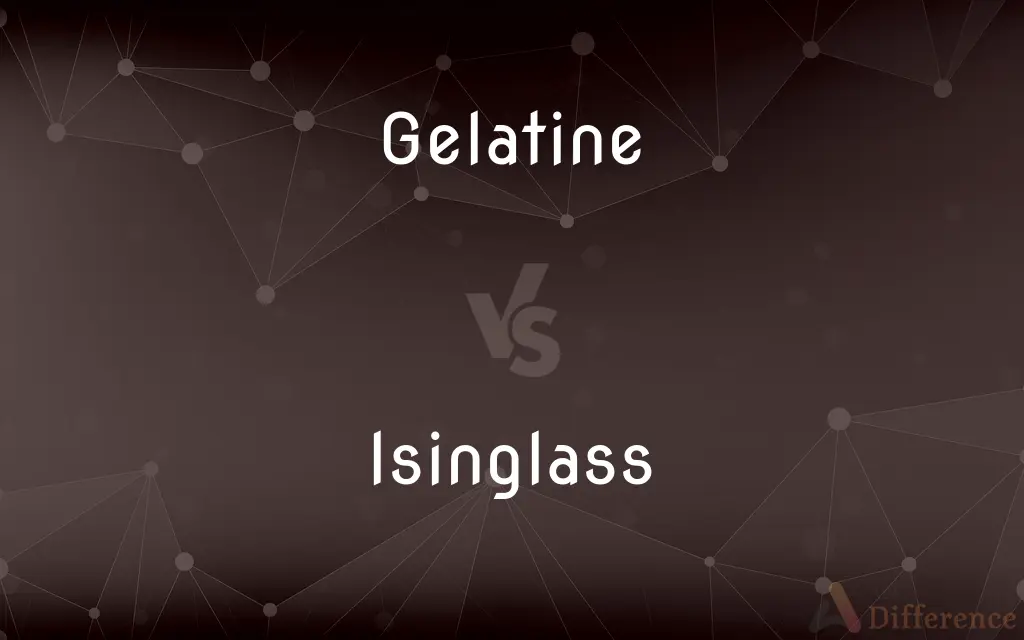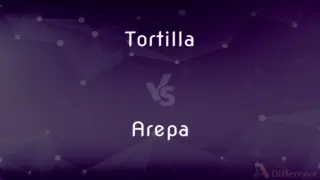Gelatine vs. Isinglass — What's the Difference?
Edited by Tayyaba Rehman — By Urooj Arif — Updated on May 9, 2024
Gelatine is a protein derived from collagen in animal parts, used widely in food; isinglass is a form of gelatin from fish bladders, primarily used in clarifying beverages.

Difference Between Gelatine and Isinglass
Table of Contents
ADVERTISEMENT
Key Differences
Gelatine is obtained by boiling animal bones, skin, and connective tissues and is a common ingredient in foods like gummies and marshmallows. Whereas, isinglass, sourced from the dried swim bladders of fish, is traditionally used to clarify beer and wine.
Both gelatine and isinglass serve as clarifying agents, but gelatine is more versatile in the culinary world, used in desserts, as a thickener, and in confectionery. On the other hand, isinglass is almost exclusively used in the brewing and winemaking industries.
The processing of gelatine involves various sources including pork, beef, and poultry. Whereas isinglass is specifically derived from certain types of freshwater fish, making it limited in source but preferred in specific dietary contexts.
In dietary terms, gelatine is not suitable for vegetarians and certain religious groups due to its animal origin. Isinglass, while also animal-derived, sometimes appeals to pescatarians who do not consume other meats.
Nutritionally, both provide protein, but gelatine is more commonly recognized in everyday diets and supplements, contributing to joint health and skin elasticity. Isinglass, though also protein-rich, is typically consumed in negligible amounts through its residual presence in beverages.
ADVERTISEMENT
Comparison Chart
Source
Animal bones, skins, tissues
Fish swim bladders
Primary Use
Food additive, gelling agent
Beverage clarification
Dietary Suitability
Not vegetarian/vegan-friendly
Sometimes suitable for pescatarians
Availability
Broad and diverse
Limited to specific fish sources
Nutritional Value
Used in dietary supplements
Consumed in trace amounts
Compare with Definitions
Gelatine
Acts as a thickener in food products.
Gelatine thickens yogurts and cream pies.
Isinglass
Considered more environmentally friendly compared to chemical alternatives.
Isinglass is a natural alternative to synthetic fining agents.
Gelatine
Employed in pharmaceuticals as capsule coatings.
Gelatine capsules are common in medication.
Isinglass
Used historically for gluing and bookbinding.
Isinglass was once a popular adhesive in bookbinding.
Gelatine
A protein obtained by boiling animal parts, used as a gelling agent.
Gelatine is used to set jellies and puddings.
Isinglass
Minimal impact on flavor, making it ideal for beverages.
Isinglass does not alter the taste of beer.
Gelatine
Integral in confectionery items to give chewy texture.
Gummy bears are made with gelatine.
Isinglass
A substance obtained from the dried swim bladders of fish.
Isinglass is used to clarify beer during brewing.
Gelatine
Used in photography for film production.
Gelatine is a key component in photographic films.
Isinglass
Employed in clarifying wines and some dairy products.
Winemakers use isinglass to refine the clarity of white wine.
Gelatine
A colorless or slightly yellow, transparent, brittle protein formed by boiling the specially prepared skin, bones, and connective tissue of animals and used in foods, drugs, and photographic film.
Isinglass
Isinglass () is a substance obtained from the dried swim bladders of fish. It is a form of collagen used mainly for the clarification or fining of some beer and wine.
Gelatine
Any of various similar substances.
Isinglass
A kind of gelatin obtained from fish, especially sturgeon, and used in making jellies, glue, etc. and for fining real ale.
Gelatine
A jelly made with gelatin, used as a dessert or salad base.
Isinglass
Mica or a similar material in thin transparent sheets.
Gelatine
A thin sheet made of colored gelatin used in theatrical lighting. Also called gel.
Isinglass
A transparent, almost pure gelatin prepared from the swim bladder of the sturgeon and certain other fishes and used as an adhesive and a clarifying agent.
Gelatine
Same as Gelatin.
Isinglass
Mica in thin, transparent sheets.
Gelatine
A colorless water-soluble glutinous protein obtained from animal tissues such as bone and skin
Isinglass
A form of gelatine obtained from the air bladder of the sturgeon and certain other fish, used as an adhesive and as a clarifying agent for wine and beer.
Isinglass
A thin, transparent sheet of mica (probably from its similarity to true isinglass).
Isinglass
A semitransparent, whitish, and very pure form of gelatin, chiefly prepared from the sounds or air bladders of various species of sturgeons (as the Acipenser huso) found in the rivers of Western Russia. It used for making jellies, as a clarifier, etc. Cheaper forms of gelatin are not unfrequently so called. Called also fish glue.
Isinglass
A popular name for mica, especially when in thin sheets.
Isinglass
Any of various minerals consisting of hydrous silicates of aluminum or potassium etc. that crystallize in forms that allow perfect cleavage into very thin leaves; used as dielectrics because of their resistance to electricity
Common Curiosities
Why is isinglass preferred in the brewing industry?
Isinglass is preferred due to its ability to clarify beverages without affecting the taste.
What are the main differences between gelatine and isinglass?
Gelatine is derived from various animal parts, while isinglass is specifically derived from fish swim bladders.
Are there any religious or ethical concerns with using gelatine or isinglass?
Yes, some religious groups avoid these due to their animal origins, and vegetarians and vegans also avoid them for ethical reasons.
Is isinglass still used in modern brewing?
Yes, isinglass is still used in many traditional breweries to clarify beer and wine.
What are the health benefits of consuming gelatine?
Gelatine is known for supporting joint health, improving skin elasticity, and aiding digestion.
How does isinglass clarify beverages?
Isinglass helps to precipitate suspended particles, clearing the beverage without altering its flavor.
Can isinglass be detected in the final product of beer or wine?
Isinglass is used in such small amounts and usually fully precipitates out, making it undetectable in the final product.
How sustainable is the production of gelatine and isinglass?
The sustainability can vary; however, both are derived from byproducts of the food and fishing industries, adding a level of resource efficiency.
What impact does the use of isinglass have on the clarity and stability of wine?
Isinglass improves both the clarity and stability of wine by removing proteins that could cause haziness or sediment formation.
Can gelatine be used in vegan products?
No, gelatine is not suitable for vegan products as it is derived from animal parts.
Is there a plant-based alternative to gelatine?
Yes, agar-agar and pectin are popular plant-based alternatives to gelatine.
What is the typical concentration of gelatine used in food products?
Gelatine concentration can vary, but it typically ranges from 1% to 5% in food products to achieve the desired texture.
How are gelatine and isinglass similar?
Both are protein-based and used as clarifying agents, although their applications differ significantly.
Are there any modern synthetic alternatives to gelatine and isinglass?
Yes, synthetic alternatives like synthetic polyvinyl polypyrrolidone (PVPP) are used, especially in vegan-friendly wines and beers.
Can allergic reactions occur from either gelatine or isinglass?
Yes, some individuals may experience allergic reactions to either substance, particularly if they have sensitivities to specific animal proteins.
Share Your Discovery

Previous Comparison
Art vs. Discipline
Next Comparison
Tortilla vs. ArepaAuthor Spotlight
Written by
Urooj ArifUrooj is a skilled content writer at Ask Difference, known for her exceptional ability to simplify complex topics into engaging and informative content. With a passion for research and a flair for clear, concise writing, she consistently delivers articles that resonate with our diverse audience.
Edited by
Tayyaba RehmanTayyaba Rehman is a distinguished writer, currently serving as a primary contributor to askdifference.com. As a researcher in semantics and etymology, Tayyaba's passion for the complexity of languages and their distinctions has found a perfect home on the platform. Tayyaba delves into the intricacies of language, distinguishing between commonly confused words and phrases, thereby providing clarity for readers worldwide.
















































